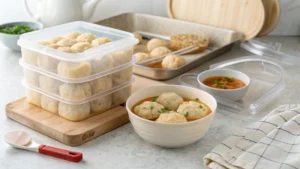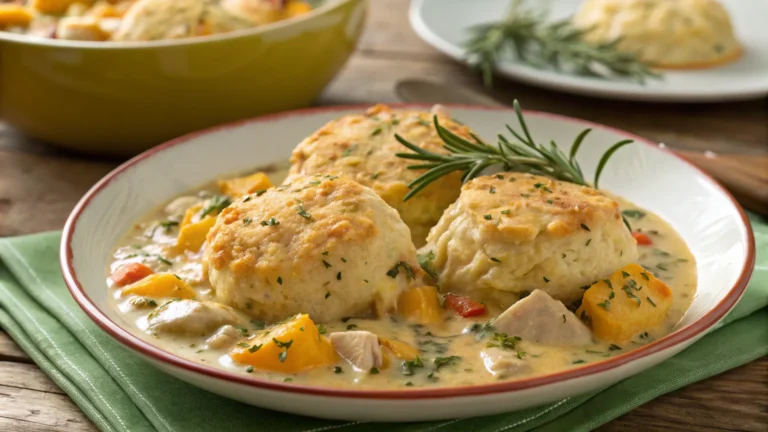Dumplings are the crowning glory of a warm, hearty stew. But what happens when they disintegrate into a soupy mess? Whether you’re a seasoned cook or a newbie in the kitchen, learning how to keep biscuit dumplings from falling apart can feel like a mystery. This article breaks down the causes behind crumbly dumplings and offers foolproof tips to achieve tender, yet firm, biscuit dumplings every time. Let’s dive in!
Understanding Biscuit Dumplings
What Are Biscuit Dumplings?
Biscuit dumplings are a simple, comfort-food staple made from a dough similar to biscuits. They’re dropped into a simmering pot of broth or stew to cook, soaking up flavors while adding a soft, pillowy texture to the dish. These dumplings have been beloved in cuisines worldwide, from American chicken and dumplings to European-style doughy delights.
The allure of biscuit dumplings lies in their versatility and simplicity. But, as anyone who has cooked them knows, achieving that perfect balance firm enough to hold together yet tender enough to melt in your mouth can be tricky.
Common Challenges in Cooking Biscuit Dumplings
When dumplings don’t hold their shape, it’s usually due to issues in preparation or cooking technique. Sticky dough, incorrect simmering, or even overhandling can turn dumplings into a dissolved mess.
Here are the most common challenges:
- Dough Consistency: Too wet, and the dumplings won’t hold together; too dry, and they become dense and unappetizing.
- Cooking Technique: Plunging dumplings into boiling broth might make them fall apart.
- Timing: Rushing the process can compromise their texture.
Understanding these challenges is the first step toward mastering how to keep biscuit dumplings from falling apart. In the next part, we’ll explore the specific reasons this happens and how to avoid them.
Key Reasons Biscuit Dumplings Fall Apart
Incorrect Dough Consistency
One of the most common culprits behind falling-apart dumplings is dough consistency. If your dough is too wet or sticky, the dumplings will break apart in the broth. On the flip side, if the dough is too dry, the dumplings can become crumbly and lack structure.
To avoid this, aim for a dough that feels slightly sticky but not overly wet. A good test? Press a bit of dough between your fingers. If it holds its shape without sticking excessively, you’re on the right track. Adding a bit more flour or liquid, as needed, can help achieve the perfect consistency.
Overcooking or Underboiling
The way you cook your dumplings matters just as much as the dough itself. Dropping dumplings into a rapidly boiling pot can cause them to break apart almost instantly. On the other hand, if the broth isn’t hot enough, the dumplings may absorb too much liquid, turning into mush.
The key is to simmer, not boil. Bring your broth to a gentle simmer before adding the dumplings. Once they’re in, avoid stirring aggressively, which could also cause breakage. Covering the pot while the dumplings cook allows steam to work its magic, helping them stay intact.
Lack of Preparation Techniques
Sometimes, a little prep work can go a long way in preventing issues. Shaping the dough into small, uniform pieces ensures even cooking and helps the dumplings maintain their structure. Letting the dough rest for a few minutes before cooking also helps gluten develop, giving the dumplings more resilience.
If you’ve ever wondered how to keep biscuit dumplings from falling apart, proper preparation is a game changer. Taking just a few extra steps ensures your dumplings stay intact and delicious.
Step-by-Step Guide to Making Perfect Biscuit Dumplings
Ingredients and Tools You’ll Need
Creating flawless biscuit dumplings starts with the right ingredients and tools. You’ll need:
- All-purpose flour (or a gluten-free alternative for dietary needs).
- Baking powder for a light, fluffy texture.
- A small amount of fat (butter, shortening, or oil).
- Milk or water to bind the dough.
- A sturdy mixing bowl and a pot with a lid for cooking.
Having everything prepped before you start helps the process run smoothly and reduces mistakes.
Preparing the Dough
The foundation of great biscuit dumplings is in the dough. Start by mixing your dry ingredients (flour, baking powder, and a pinch of salt) in a bowl. Cut in the fat until the mixture resembles coarse crumbs. Gradually add the liquid, mixing just until the dough comes together.
Avoid overmixing, as this can make the dumplings tough. Aim for a slightly sticky dough that holds its shape when scooped or rolled.
Cooking Techniques to Prevent Falling Apart
Now comes the crucial step cooking. Bring your broth or stew to a gentle simmer, not a rolling boil. Scoop small portions of dough (a tablespoon or so) and drop them into the liquid.
Cover the pot immediately and resist the urge to peek for at least 15 minutes. The steam trapped inside will cook the dumplings evenly and help them hold their shape. When done, the dumplings should be firm to the touch and float to the surface.
Enhancing Flavor Without Compromising Structure 
Using Broth for Better Results
Broth does more than cook your dumplings it’s the key to their flavor and texture. Choosing a rich, homemade broth instead of store-bought ensures the dumplings absorb a depth of flavor while maintaining their form. Add herbs and spices like thyme, parsley, or bay leaves to the broth to infuse your dish with complexity without overpowering the delicate dough.
If you’re wondering how to keep biscuit dumplings from falling apart, make sure your broth isn’t boiling aggressively. A gentle simmer allows the dumplings to cook evenly and soak up the flavorful liquid without falling apart.
Adding Binding Ingredients
Adding a small amount of binding ingredients, such as eggs or cornstarch, to the dough can significantly improve the structure of biscuit dumplings. These additions work like a glue, holding the dough together as it cooks. Be cautious not to overdo it, though—too much can make your dumplings dense and rubbery.
Binding agents are especially useful if you’re experimenting with gluten-free or alternative flours, which can be trickier to work with. This little tweak can make a huge difference in achieving that perfect texture.
Experimenting with Spices and Herbs
Flavorful dumplings don’t have to rely solely on the broth. Try adding finely chopped herbs, grated cheese, or a pinch of garlic powder directly into the dough. These simple additions can elevate your dumplings without affecting their structure.
For those seeking additional inspiration, check out this article about Cracker Barrel Chicken and Dumplings for ideas on incorporating traditional flavors into your recipes.
FAQs
Why Are My Dumplings Falling Apart Even with Careful Preparation?
Even if you follow the recipe, several factors could still cause issues. If the broth temperature fluctuates too much or you stir the pot too often, the dumplings might break apart. Ensure that the dough is properly mixed but not overworked, and keep the broth at a consistent simmer.
Can I Use Store-Bought Dough?
Yes, but with caution. Pre-made dough can work in a pinch, but it’s often designed for baking, not simmering. Adjust the moisture levels and add a binding ingredient to improve the dough’s performance in a liquid environment.
Is It Better to Boil or Steam Biscuit Dumplings?
Steaming can work well for firmer dumplings, but simmering in broth yields the best flavor. Keep the broth just below a boil to avoid disintegration. A lid on the pot during cooking helps trap steam and ensures even cooking.
For more delicious dumpling recipes and tips, explore the ultimate guide to Bisquick dumplings on Larde Recipes.
Creative Variations for Biscuit Dumplings
Incorporating Cheese and Herbs for a Gourmet Twist
Biscuit dumplings are a blank canvas for flavor. Adding shredded cheese like cheddar or Parmesan directly into the dough can create a rich, indulgent variation. For an herby kick, sprinkle in chopped parsley, dill, or thyme. These additions not only enhance the flavor but also make your dumplings a standout feature in any stew.
If you’re pairing your dumplings with lighter dishes like chicken broth, the subtle tang of cheese can add depth without overpowering the dish. To experiment further, try combining bold ingredients like garlic powder or smoked paprika into the dough.
Making Sweet Dumpling Variations
Biscuit dumplings aren’t just for savory dishes they can transform into a delightful dessert! Replace a portion of the flour with cocoa powder or cinnamon and add a touch of sugar for a sweet variation. These sweet dumplings can be simmered in a fruit compote or topped with a drizzle of honey for an indulgent finish.
Sweet dumplings pair beautifully with unique dishes like cookie cakes or fruit-based desserts, making them a versatile choice for your recipe repertoire. They’re especially popular in celebrations where creativity shines.
Serving Suggestions and Pairings
Classic Pairings for Biscuit Dumplings
Traditionally, biscuit dumplings shine in hearty dishes like chicken and dumplings or beef stew. Their pillowy texture complements rich, thick broths, creating a satisfying balance of flavors. For a southern twist, pair them with a savory gumbo or a creamy sausage gravy.
Adding vegetables like carrots, celery, and peas to the dish not only enhances nutrition but also creates a colorful presentation. The combination of tender meat, fresh vegetables, and perfectly cooked dumplings makes for a timeless comfort meal.
Modern Takes and Unusual Pairings
For a modern spin, serve biscuit dumplings with lighter dishes such as roasted vegetable soups or creamy tomato bisques. Their mild flavor and soft texture provide a pleasing contrast to robust soups and fresh salads.
Dumplings can also double as a unique topping for unconventional dishes. For instance, they pair surprisingly well with sweet treats like cookie cakes. A warm chocolate chip cookie cake served alongside a dollop of sweetened dumplings creates an unexpected yet delightful pairing.
Common Mistakes to Avoid When Cooking Dumplings
Using the Wrong Dough Consistency
One of the most frequent issues cooks face is preparing dough with the wrong consistency. If the dough is too wet, the dumplings will disintegrate, especially when simmered in a hot broth. Conversely, overly dry dough can result in dense, tough dumplings that lack the desired fluffiness.
To address this, it’s crucial to balance wet and dry ingredients carefully. Always add liquid gradually, mixing gently until the dough is slightly sticky but still holds its shape. By focusing on this step, you’ll solve one of the primary causes of the question, “How do you keep biscuit dumplings from falling apart?
Overcrowding the Pot
Cooking too many dumplings at once can be another recipe for disaster. When overcrowded, dumplings may stick together or cook unevenly, leading to clumps and broken pieces. To avoid this, cook dumplings in batches, leaving enough space in the pot for each to float freely.
If you’re making dumplings for a large group, keep your broth at a steady simmer, and use a slotted spoon to remove the first batch before cooking the next. This simple adjustment keeps your dumplings intact and ensures even cooking.
Tips for Storing and Reheating Dumplings
Proper Storage Techniques
Leftovers can be just as delicious as fresh dumplings—if stored correctly. Once your dumplings have cooled, transfer them to an airtight container. Be sure to separate them from the broth if possible, as prolonged soaking can make them soggy and prone to falling apart.
If you need to store dumplings for longer periods, freezing is a great option. Lay them out on a baking sheet and freeze individually before transferring them to a freezer-safe bag. This method prevents clumping and preserves their texture.
Reheating Dumplings Without Compromising Texture
When it’s time to reheat, choose your method carefully. Microwaving can sometimes make dumplings rubbery or unevenly heated. Instead, warm them gently on the stovetop by simmering them in broth. This reheating method not only revives the dumplings but also keeps them flavorful and tender.
For those who’ve struggled with the problem, “How do you keep biscuit dumplings from falling apart?” during reheating, this gentle approach ensures your dumplings remain intact while tasting as good as the day they were made.



